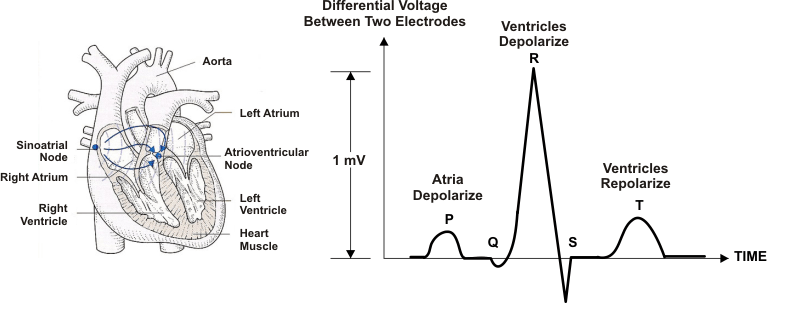SLAA486B January 2011 – June 2019 MSP430G2452
1 Introduction
The source of the human heart beat is an electrical pulse generated by a cluster of cells within the heart called the sinoatrial (SA) node [1]. This pulse travels from the SA node through the surrounding cells of the heart and then to the atrioventricular (AV) node. The AV node acts as a gate that allows the atria to finish contraction before allowing the pulse to move on to the ventricles. Each atrium pumps blood to a corresponding ventricle. The right atrium pumps blood to the right ventricle to provide blood to the lungs. The left ventricle, sourced by the left atrium, is the chamber that pumps blood throughout the body.
 Figure 1. Human Heart Anatomy (left) and EKG Waveform (right)
Figure 1. Human Heart Anatomy (left) and EKG Waveform (right) The electrocardiogram (ECG) or elektrokardiogramm (EKG) is a medical standard for testing the human heart for defects and diseases [2]. Figure 1 shows the anatomy of the human heart and the waveform of the EKG signal. The EKG waveform can be used for extrapolation of data such as the number of heartbeats per minute (BPM) and the values can range from 30 to 200 BPM or 0.5 to 4 Hz.
The typical amplitude of the R wave component of the EKG signal is approximately 1 mV [3]. This peak is located within a group of peaks known as the QRS complex and represents the electrical pulse flowing through the ventricles. As this pulse travels through the blood stream, it can be detected at various points on the body. The extremities and the chest have become the standard locations for placing electrodes for acquiring the EKG signal. In this application, the subject’s finger tips act as the differential point of contact with conductive pads to detect the EKG signal.